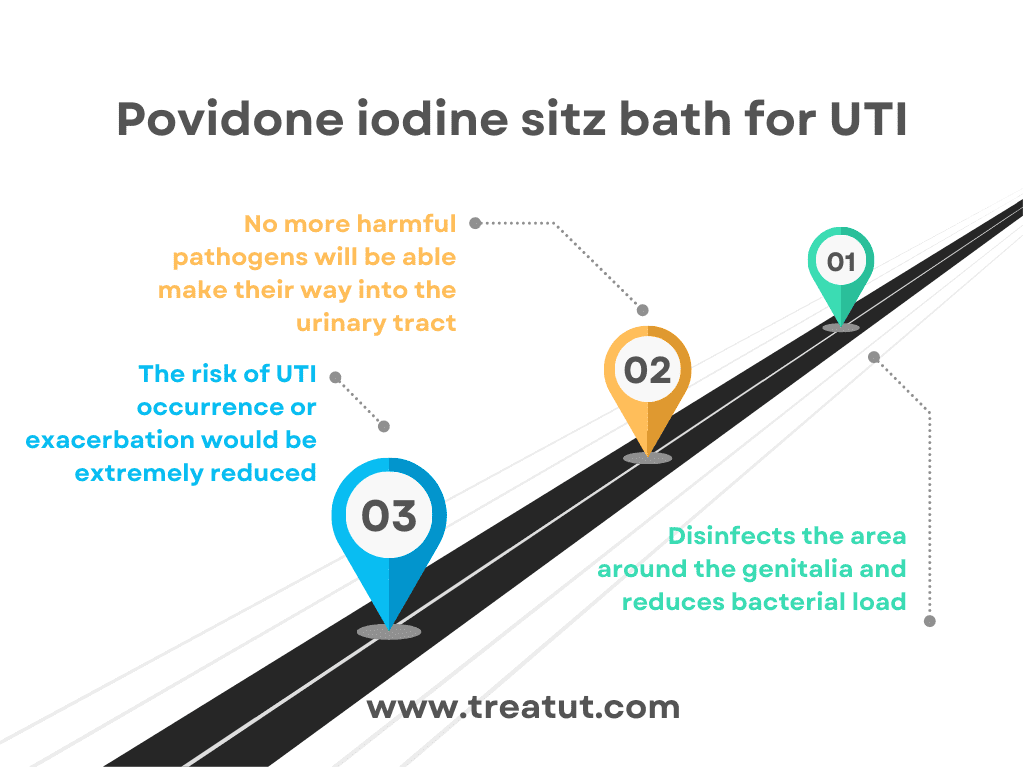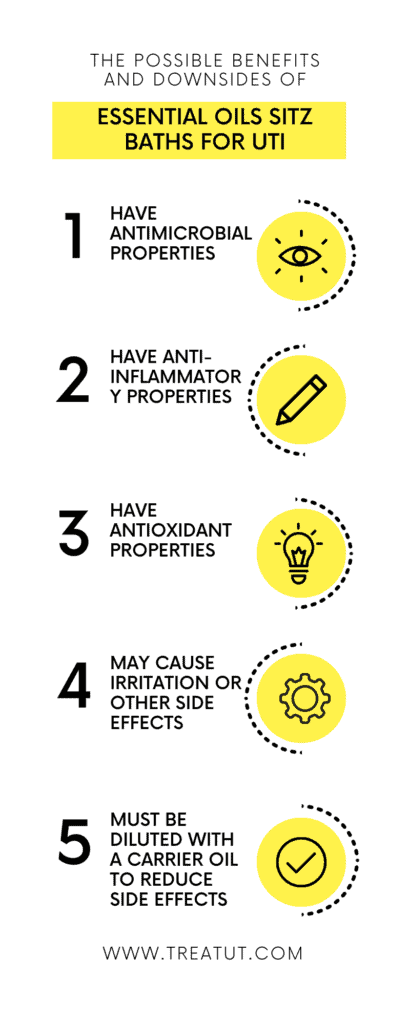You can add vinegar, Epsom salt, essential oils or olive oil to your sitz baths in order to increase their effectiveness for UTI, but you must use these kinds of baths in a careful and correct manner to get the maximum benefits out of them without any unwanted effects.
UTIs are not cured with these kinds of baths, but you can view them as some kind of tool or assistance to help you in the treatment and prevention process of UTI.

UTI patients and people in general can add some ingredients to their sitz baths in order to boost their effectiveness for UTI and for many other conditions as well.
Sometimes, even doctors advise patients to add some kind of medication or remedy to their baths for a specific reason.
This reason could be because they want to prevent bacterial or fungal infections after surgery in order to promote faster wound healing.
Sometimes doctors even prescribe sitz baths for patients to reduce bacterial load in the perineal region or to reduce pain in that area.
For example, oftentimes doctors prescribe cold water sitz baths for hemorrhoid patients or for patients who have gone through hemorrhoidectomy (hemorrhoid removal surgery).
For more information about the more standard kinds of sitz baths, which are warm and cold water sitz baths, please visit our sitz bath for UTI article.
Also, doctors can prescribe povidone-iodine or Epsom salt with sitz baths after any kind of anorectal surgery (surgeries that involve the anus or any part of the genital area).
Moreover, this kind of treatment can even be given to patients with anal fissures and even UTI patients because as we said we need to disinfect the area around the genitals or decrease bacterial load and decrease pain.
Note: bacterial load is the number of harmful or pathogenic bacteria around a specific kind of area or region, so the less of it we have the better.
Mostly, for UTI patients, doctors prescribe only warm water sitz baths, but povidone iodine sitz baths and other kinds of sitz baths can also be prescribed for them.
What ingredients should we put in a sitz bath to improve their effectiveness for UTI?
Recently, there have emerged new kinds of ingredients that people are now using in their sitz baths that some doctors are beginning to notice that they have some benefits for people with problems around the genital area Including UTI.
So, here are the best kinds of add-ins that we think you can add to your sitz bath to help you with your UTI.
Povidone iodine (Betadine)
This antiseptic solution medication is often added by doctors to patients’ sitz baths after any kind of anorectal surgery for example after a haemorrhoidectomy (the removal of hemorrhoids by surgical intervention).
It can help in speeding up wound healing after surgery and in reducing pain because of its anti-septic (germ-killing) properties. See this study.
What do antiseptic solutions do?
Antiseptic solutions like povidone-iodine can eradicate all living organisms like bacteria, fungi and so on, on the surface on which it was applied, for example, the skin.
So, for UTI patients this quality may come in handy because if this solution was added in the right amount to UTI patients’ sitz bath water, it can help kill the bacteria around the genital area and reduce bacterial load.
You should know by now that when there are no bacteria or a lesser amount of bacteria around the perineal region or genital area, then the possibility of UTI exacerbation or worsening would be reduced as no further bacteria would be able to enter the urinary tract through that route.
It would also be good in terms of UTI prevention to use this medication occasionally with sitz baths because of the obvious benefit of preventing any significant amount of bacteria or germs from gathering around the genitalia and entering the urinary tract.
The area around the genitalia, especially around the anus, is usually filled with bacteria, and some of that bacteria can be harmful and could cause a UTI or exacerbate an already existing one if circumstances allow them.
So, the antiseptic properties of povidone-iodine sitz baths give these baths a great advantage in comparison to the ordinary warm water ones because warm water sitz baths do not have that much of a great ability to kill bacteria directly and right away.
However, there are some side effects that can be associated with adding povidone iodine solution to sitz baths including irritation, poisoning or iodine toxicity.
These last two side effects are more likely to happen in the case of the existence of an open wound around the perennial region and/or the use of a high concentration or a high amount of povidone iodine in the sitz bath.
Being exposed to povidone-iodine solutions for more than is required can also increase the likelihood of side effects.
So, the proper amount of povidone solution that must be added to the sitz baths should be well known to UTI people who are willing to use this kind of treatment for their UTI.
The best dilution ratio to be used in povidone-iodine sitz baths is one to 200, which means every one ML of 10% povidone-iodine solution should be diluted with 200 ML of water.
For helping in UTI treatment or prevention purposes, people should use this kind of sitz bath two times a day for 2 to 3 days.
Do not soak in the bath for longer than 15 minutes, and if you think that you are susceptible to allergies, irritations or iodine toxicity, then soak for only 10 minutes.
Remember to wash out the area thoroughly after the sitz bath and then dry yourself out with a soft piece.
If symptoms worsen or persist, then, of course, patients should refer back to their doctors, and if allergies appear, they should discontinue the treatment.
For people who have more sensitive skin or a higher likelihood of iodine toxicity, for example they have hypothyroidism, then they should dilute it even more using a 1 to 300 ratio of provident iodine (betadine) to water.
However, in general, the possibility of iodine toxicity with povidone-iodine sitz baths is extremely rare, and there are only a few cases in the whole history of medicine that have been reported of them and no more.
Another side effect of this kind of bath is that while it can kill harmful organisms residing in the perineal region, it can also get rid of some beneficial bacteria living in that area, especially if people use it consistently.
Reductions in the population of skin microflora can lead to the skin being more vulnerable to different kinds of infections and diseases in the long run.
But, that is not likely to happen, especially if you do not use povidone iodine sitz baths for more than is recommended.

Epsom salt
Although it’s not a salt in the usual sense of the word, magnesium sulfate or Epsom salt is, scientifically speaking, a kind of salt.
All kinds of salt, when added to water, make a kind of high osmolarity solution that forces the water inside the bacteria to rupture out of the cell wall, Killing the bacteria in the process.
This means that magnesium sulfate (Epsom salt) does have antibacterial properties, which can be useful for UTI patients when they add it to their regular water sitz baths.
Because of these antibacterial properties, Epsom salt sitz baths can help disinfect or kill some of the bacteria around the perineal region.
It can also help to some extent with the inflammation associated with UTI.
Just like the ordinary warm water sitz baths, it can help ease some of the discomfort, irritation and pain symptoms associated with UTI or cystitis.
By reducing inflammation and bacterial load, this kind of bath can help to some extent the genital area regain back its immunity against harmful bacteria.
Although studies and many medical blogs on the internet point out that this kind of salt cannot be absorbed in significant amounts through the skin and into the bloodstream through taking a bath, but that’s not the point.
Just the ability of this kind of bath to deliver magnesium and sulfate ions into the outermost layers of the skin is going to be enough as from there, these ions, especially magnesium, can work on helping the skin of the perineal region regain back its strength.
Studies indicate that magnesium ions can penetrate to even further than the outermost layers of the skin, which is a very good sign that Espom salt baths in general do work.
Epsom salt sitz can reduce irritation and offer some soothing, relaxing, antibacterial and anti-inflammatory effects on the skin around the genitalia, and that would be considered as some kind of help for UTI patients and for people who want to prevent UTI.
Our bodies, including the skin, usually lack magnesium.
An Epsom salt bath can offer some nourishment to the skin around the perineal region, which can help it fight infections like the UTI.
This study shows the great anti-inflammatory potential that Epsom salt baths have.
The sitz bath managed to reduce pain in arthritis patients, which is a condition greatly associated with inflammation.
Epsom salt sitz baths can also exert antioxidant effects on the skin, which is an advantage that cannot be found in regular warm water sitz baths.
This antioxidant activity can be considered as an added layer of protection against UTI-causing germs.
To make a good Epsom salt sitz bath, fill the bathtub 3 to 4 inches deep (just deep enough so that the water can cover your hips) and then add 1/2 a cup of Epsom salt to the water and mix it up.
If you are using a store-bought sitz bath basin or pan, then also add the same amount of Epsom salt.
The important thing to do here is to remember to wash out the area thoroughly after the sitz bath and then dry yourself out with a soft piece of cloth in order to prevent possible irritation and moisture.

Vinegar
This is one of the best kinds of add-in ingredients that you can use with a sitz bath.
The only problem with this kind of sitz bath is also the possibility of allergy or irritation, but that possibility can be extremely reduced with using the right amount of dilution.
Vinegar, especially apple cider vinegar and other kinds of fruit vinegar, has extraordinary antibacterial, antifungal, anti-inflammatory, antioxidant and even immunomodulatory properties.
The antibacterial and antifungal activities of vinegar can help kill or impede the growth of bacteria and fungi around the perineal region.
While, the anti-inflammatory, immunomodulatory and antioxidant activities can help protect and rebuild the skin barrier around that area and strengthen the immunity there.
So, this kind of sitz bath can definitely help with UTI whether people use it with an ongoing UTI or for the purpose of UTI prevention.
More information on vinegar baths and their effectiveness for UTI can be found here.
In a standard 2 liter sitz bath, you should use about 30ML of vinegar, which is approximately equivalent to 2 tablespoons.
The lesser the amount of water you use the lesser vinegar you should add so as to prevent irritation and allergies.
Soak your perineum in the bath for about 10 to 15 minutes.
This bath will not only reduce bacterial load around your perineal region but will also strengthen its immunity and make it more resilient or resistant in the face of infections, like the urinary tract infection (UTI).
Essential oils
People sometimes add different kinds of essential oils to their regular baths or sitz baths due to their relaxing properties.
Surprisingly enough, many studies have shown that these compounds have great promise because they possess antibacterial, antioxidant and anti-inflammatory properties.
Some studies even show that some essential oils, like lavender oil, are as effective as betadine (povidone-iodine) in wound healing after surgery.
However, these compounds have also shown that they possess a great potential for causing allergy and toxicity whether used topically on the skin or ingested by mouth, especially if used in the undiluted form.
To mitigate this problem people can dilute these essential oils with carrier oils, like olive oil or coconut oil, in order to reduce the possibility of side effects.
Carrier oils like coconut oil and olive oil also possess some good antibacterial, anti-inflammatory and antioxidant properties in and of themselves.
So, diluting the essential oils that you are going to use with them before adding the concoction (mixture) to the sitz bath is not only the safest but also the most effective and beneficial way to help with your UTI.
For example, you can mix 1-2 drops of lavender oil or tea tree oil with one tablespoon of olive oil and then add the mixture to your sitz bath.
Soak in the bath 2 times a day for about 10 minutes, for 2-3 days or as needed.
The combined antibacterial, antifungal, antiviral, anti-inflammatory and antioxidant effects of both the essential oils and the carrier oils will help cleanse and reduce infection and/or inflammation around the area between the anus and the urethra (the perineum).
This can be extremely beneficial for UTI patients and for people who suffer from recurrent UTIs and want to prevent them.
People who have UTI should never use essential oils in any other kind of way in their sitz baths as using them (undiluted) or in more risky ways may increase inflammation or irritation around the genital area, which may exacerbate UTI.
If irritation, allergy or any other kind of side effect appears when using essential oils sitz baths, people should discontinue their use immediately and refer to the doctor.
This study shows the great potential of side effects that this kind of aroma therapy can cause to people.
After using an essential oil sitz bath, the genital area must be washed thoroughly with water and then dried out to prevent irritation and the possibility of a fungal infection.

Olive oil
Olive oil is extremely safe and studies have found that olive oil sitz baths can be used in the treatment of wounds after surgeries that are done in the perennial region (anorectal surgeries).
This study has found that olive oil sitz baths can speed up the recovery and wound healing process after delivery surgery.
This means that this remedy does have antiseptic and anti-inflammatory properties.
Due to these beneficial properties and because of their safety profile olive oil sitz baths can be recommended for UTI patients and for people who want to prevent UTI.
Just put a tablespoon of olive oil in your sitz bath water and soak in the bath for about 10 to 15 minutes and you’re good to go.
Use this bath 2 times a day for 2-3 days if you have an ongoing UTI and as needed if you want to prevent UTI.
Remember to wash up after that thoroughly and Pat the area dry.
Other kinds of sitz baths and their effectiveness for UTI?
Here we will try to assess some popular kinds of sitz baths and see whether they can be effective for people who have UTI or not.
Baking soda sitz baths
Baking soda sitz baths can offer some soothing and relief from some UTI symptoms, although not to a great extent.
The better use of baking soda would be to dilute a sachet or a small measure of this kind of remedy in a cup of water and drink it one or two times daily in order to help with the burning sensation and discomfort and pain symptoms of UTI.
However, in general, both the baking soda sitz bath and the oral intake of baking soda can’t offer that much in terms of the actual treatment and healing of UTI.
Baking soda in and of itself does not have strong if any antibacterial or even anti-inflammatory properties to begin with.
There is also the risk of Raising the pH or the alkalinity of the skin of the perennial region.
That could expose the skin of the perineum to the threat of infections or bacterial or fungal invasions to that space between the anus and the opening of the urethra, which might end up causing or exacerbating UTI.
Therefore I won’t recommend using baking soda sitz baths for the purpose of helping with UTI treatment or even for the purpose of UTI prevention.
For more information on the regular kind of baking soda baths and their effects on people with UTI, please see our Baking soda bath for UTI article.
Neem extract sitz bath
Neem extracts can also be a good add-in to sitz baths for people with UTI and some studies show that it had great wound healing, soothing and antibacterial activities when used in sitz baths.
it’s just that this is a rather new kind of treatment so I won’t recommend using it for UTI patients, but for the purposes of UTI prevention people can experiment with using very little amounts of neem extracts in their sitz bath and beware of irritation and allergy.
For more information on the Neem herb in general and its effects on UTI, see our neem for UTI article.
Table salt sitz bath
Table salt definitely has some antibacterial activities.
This kind of salt has been used to disinfect different kinds of foods like vegetables and even meat by many cultures for generations.
These antibacterial and disinfectant properties can be useful for UTI patients who also want to kill the germs and bacteria in the area around the genitals or the perennial region.
Although I might say that this kind of salt won’t disinfect anything in the medical or scientific sense of the word, especially if there was an ongoing infection or bacterial or fungal colonization in the perineal region.
It might only help in the reduction of the number of germs around the genital area when used in a sitz bath and no more.
The other problem with this kind of remedy is the possible irritation it might cause when people who suffer from UTI use it in a sitz bath.
To mitigate this problem, just use a small measure of it maybe half of a tablespoon and add it to your regular sitz bath water, and if you find yourself becoming irritated, discontinue the bath immediately.
Using Epsom salt in your sitz bath is much better than table salt, but if you don’t happen to find it around at a particular moment, then table salt won’t be a bad alternative.
The same dosage of Epsom salt sitz bath can also apply to the table salt version.
Summary
- All of these kinds of sitz baths cannot treat a UTI on their own, and they can only be used in mild cases of UTI or for preventative purposes or as a kind of supplemental or adjunctive therapy with the doctor’s prescribed treatment.
- Vinegar sitz baths can exert some beneficial antioxidant anti-inflammatory and antimicrobial properties for UTI people.
- Epsom salt sitz baths can offer some anti-inflammatory and antimicrobial effects, so people who have UTI might be able to benefit from them.
- Essential oil sitz baths must only be used diluted with a carrier oil for them to exert their beneficial effects on UTI people.
- Baking soda sitz baths can offer only a small benefit for UTI sufferers with the risk of causing some side effects.
- Table salt sitz baths can be a good alternative to Epsom salt sitz baths if Epsom salt was not available3
